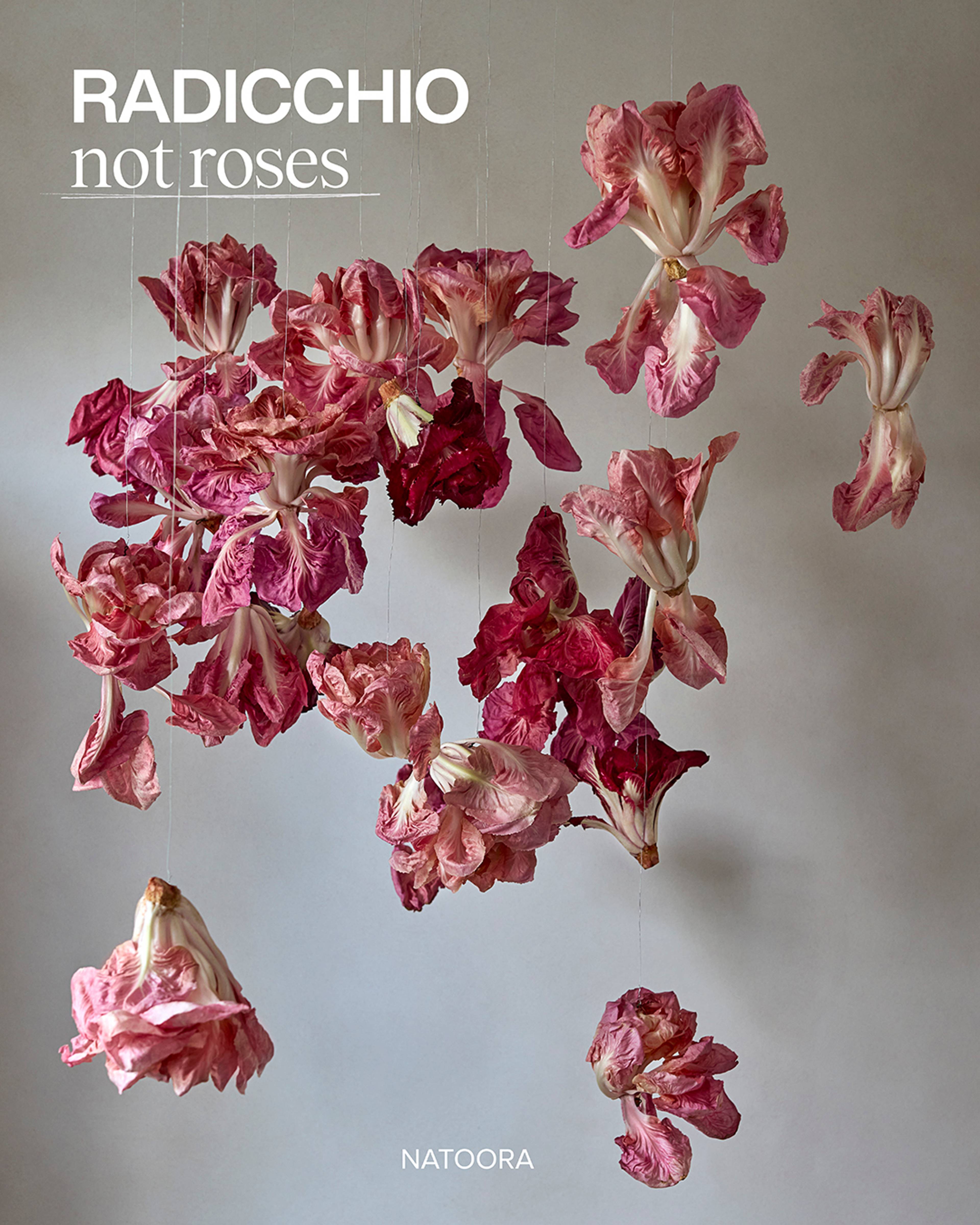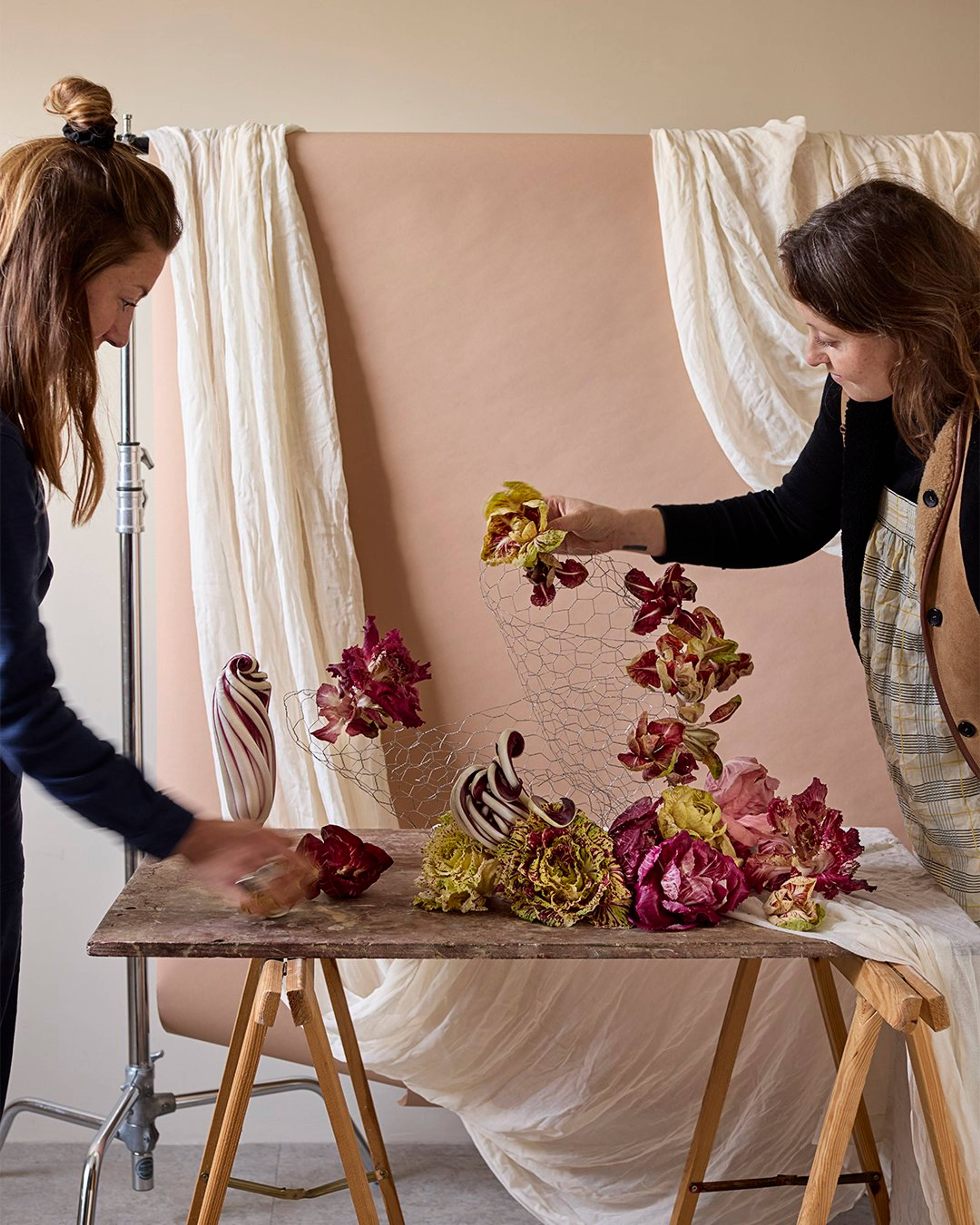RADICCHIO NOT ROSES 2024

Rosa del Veneto and Rosella di Lusia from Veneto, Italy. Arranged by Frida Kim.
This Valentine’s Day, don’t fall back on Roses. Choose Radicchio.
250 million roses are grown each year for Valentine's Day, when they are not in season. For the third year, we're asking everyone to choose a seasonal alternative: Radicchio. London florist Frida Kim brings this message to life with her floating arrangement — Antonello's Rosa del Veneto Radicchio and Rosella di Lusia, strung asymmetrically with the less-is-more aesthetic typical of ikebana floristry. Working in harmony with nature is the cue.
BACK SEASONALITY
IN FEBRUARY, ROSES ARE NOT IN SEASON IN THE US
They are grown in Latin America, specifically Colombia and Ecuador, where the climate is conducive to winter growth.[2] The success of this industry is reliant, in large part, on dangerous chemicals and low wages with detrimental social and environmental costs.[3]
To boycott imported blooms could cause a major socio-economic collapse in those countries affected, but that does not mean we have to accept the current status quo. The key is conversation.
ROSE PRESERVATION LEAVES ITS IMPRINT ON THE EARTH
Each stem requires 10 liters of water to reach full size, contributing to high water use and chemical runoff.
PRESERVE GROWING ARTISTRY
GROWING ARTISTRY ON THE BRINK OF EXTINCTION
Veneto, in Italy’s northeast, has maintained a long tradition of radicchio growing. For centuries wild chicory has been eaten here, thriving in the heavy, mineral-rich soils and fluctuating temperatures that drop below freezing for weeks at a time. Towns like Chioggia, Treviso, Castelfranco, Verona, Lusia and Gorizia all give their names to fiercely local varieties.
Earlier this year at Tamarack Hollow in Vermont, Amanda successfully trialed her first crop of forced Rosa del Veneto — proof that radicchio can thrive in the US without chemical intervention at this time of year. While we hope to see a network of US growers develop, we continue to back those on the ground in Veneto who are fighting to preserve the varieties and traditions passed down the generations.
TRADITIONAL FORCING ELEVATES FLAVOR
However, these plants were elevated into a delicacy through careful selection, the passing on of traditional wisdom, and the development of an innovative cultivation process: forcing. After an initial period of outdoor growth, growers would re-plant their chicories in the dark, their roots often immersed in soil, spring water or sand. Triggered into new growth without photosynthesis, nutrient-dense, bittersweet and firm heads would form. By 1900 there were whole exhibitions celebrating these qualities.
Today, however, a different story dominates. Most growers opt for modern varieties designed to self-blanch in the field. The result: higher yields but depleted flavor in dull or overly bitter heads.
OUR GROWERS
A decade ago we came across Antonello’s chicories at the Lusia market in Veneto. From their striking colors to their densely packed heads, we recognized quality that only comes as a result of genuine artistry. Since then, we have built relationships with a number of small-scale, traditional growers going against the odds— Luca, Damiano, Torre and Simone.
A GREATER THREAT
This year, it’s more than yield which threatens production: it’s climate change. With winters getting warmer, the hard, cold frosts so vital to the process are happening later and less frequently. As a result, Antonello has not been able to grow one of his usual varieties — Castelfranco — for the first time.
CHOOSE FLAVOR, NOT WASTE
RADICCHIO IS EATEN, NOT WASTED AT END OF LIFE
Deep purple with tight, curled leaves or rosette-shaped with red speckles, bright red with crisp white veins or all hues of pink; we challenge you to find flowers more striking and vibrant than these radicchio heads.
At the end of their life as centerpieces, radicchio plants are eaten, not wasted. Their bittersweet complexity makes them ideal for cold-weather salads. Try with lemon, anchovy and garlic dressing or preserved lime and rose vinegar. Mix with fennel and blood orange or try it wrapped around hot smoked trout and kabocha squash onigiri (as an alternative to seaweed).
It's easier than ever to choose Radicchio, not Roses. Discover diverse heads in our Mixed Radicchio Box, and make Anna Søgaard's Chèvre Chaud & Radicchio Salad.
References
1. Valentine’s Day Floral Statistics
2. BBC, The 4,000 Mile Flower Delivery
3. The International Journal of Life Cycle Assessment, A comparison of cut roses from Ecuador and the Netherlands
4. Gender, Rights & Participation in the Kenya Cut Flower Industry
5. Socio-economic and Environmental Impact of Floriculture Industry in Ethiopia
6. Circle of Blue, Blooming Controversy: What Is Killing the Wildlife in Kenya’s Lake Naivasha?
7. Flowers From the Farm, The Carbon Footprint of Flowers
8. TED, The Environmental Impact of Cut Flowers? Not So Rosy
Additional Reading
The Financial Times, How Green is Your Bouquet? The New Eco-Friendly Mindset in Floral Design
Live Frankly, Seasonal Flowers UK: Sustainable Flower Delivery
The Guardian, Roses are Dead … How to Choose a More Ethical and Original Bouquet this Valentine’s Day
Primrose Creations, Flower Waste Management: Can the Floral Industry Make a Change?
Centre for Environmental Policy Environmental Quality Research Group, Cut Flower Waste Management
Stories
See allWe exist to fix the food system.
People are more cut off from the origins of their food than ever. This makes flavor, nutrition and farming practices that protect the planet, almost impossible to find.
By working directly with growers, we create a more sustainable way forward for farming. By giving everyone the tools to understand the power of our food choices, we empower everybody to become drivers of change.
Now is the time for action. Join the food system revolution.

Go beyond four seasons
Each fruit and vegetable has its own season, with subtle shifts which happen every day. Follow their microseasons to unlock flavor at every stage.
WHAT’S IN SEASON?

Know where your food comes from
We know the name of the person behind everything we source. Recognize their growing artistry to find out exactly where your food comes from (and why that matters).
MEET THE GROWERS

Make your diet diverse
Our growers work with varieties chosen for quality and nutrition, not yield. By selecting their crops you keep heritage seeds in play, add to ecosystem biodiversity and preserve unique flavors.
GO #OFFTHEPASS
United States
© 2024 Natoora Ltd.


